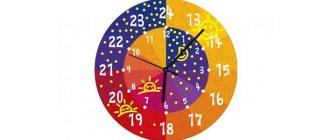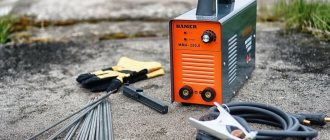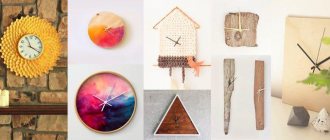A self-made sundial is a device with which you can tell the time and decorate your summer cottage. The manufacture of this device takes quite a lot of time and also requires certain knowledge and work skills. Despite this, anyone can cope with the task. To do this, you will need to study the nuances of the process and strictly follow the instructions of professionals.
How to make a sundial with your own hands for kindergarten from paper and cardboard?
There are many options for making such a device. They differ in design and operating features. Children will be happy with this invention and will learn numbers more easily. Use sand and sticks. It is better to conduct the experiment when the sand is wet. In dry weather there is no need to draw numbers. You can simply install pebbles. Say the numbers several times. At the same time, mark the time on your watch. Try to do this in a playful way.
Watch options:
- Vertical. They are located on the wall or hanging from ropes
- Horizontal . Located on the ground or on a horizontal surface
- Equatorial. Positioned at an angle. In this case, the dial is parallel to the equator line, and the hand itself is parallel to the earth's axis
Below in the video you can see how to make a simple horizontal sundial.
VIDEO: Sundial for kids
How to make a do-it-yourself sundial for a kindergarten from paper and cardboard How to make a do-it-yourself sundial for a kindergarten from paper and cardboard How to make a do-it-yourself sundial for a kindergarten from paper and cardboard
On the role of the element in the landscape
Usually the sundial is located in the center of the flower bed and is the dominant element, as it is located on a pedestal or other elevated surface. We also note that the pedestal is an important element of this composition, which is sometimes made in the form of a column.
Sundials are designed to attract attention, for this reason their size is directly related to the size of a particular area. If the area is small, then it is advisable to install the clock on a path, next to a lawn or a small but bright flower bed. But in a landscape or forest garden it is better to surround them with flowers so that they, invisible from afar, suddenly appear before your eyes when approaching. In addition, in small gardens, sundials are often installed in the form of decorative figurines.
Thanks to the huge variety of materials and shapes used to create a clock, you can get a design that takes into account the characteristics of the garden where it is created. So, if the garden is in an avant-garde style, but when creating a sundial, the most insignificant details should be taken into account. Here the clock can become part of a recreation area, a playground or even a gazebo. Moreover, they can effectively decorate a garden pond or fountain.
There is a concept of “live clock”. This is another option for how to make a sundial with your own hands, but using flowering living plants, which will serve as the material for forming the dial and hands.
Sundial ideas for kindergarten: photos
There are a huge number of options for making sundials. These can be simple products made from cardboard and paper. In kindergarten they can be made directly on the sand. To do this you will have to draw simple shapes. This is an entertaining and exciting game for preschool children. At the same time, kids learn numbers and understand how to navigate in time. Below are the main options for sundials. You can get ideas for your crafts and inventions.
Sundial ideas for kindergarten
Sundial ideas for kindergarten Sundial ideas for kindergarten Sundial ideas for kindergarten Sundial ideas for kindergarten Sundial ideas for kindergarten
How to make a simple sundial with your own hands?
Clock made from a compass and a stick
This product is made with a compass and a stick. It can be replaced with a match or toothpick.
Instructions:
- Place the compass on a flat surface, then determine the direction of the cardinal direction NORTH, place the compass panel so that the arrow points to the north and 180 degrees azimuth to the compass number.
- Place a toothpick directly in the center of the dial. That's it, the sundial is ready. To determine the time, you just need to watch the shadow of the toothpick. The longer the shadow, the more time.
- When the shadow shows 180 degrees on the dial, it is equal to 12 o'clock in the afternoon, if at 270 degrees, then it is equal to 18 o'clock, and at 90 degrees, it is equal to 6 am. That is, one hour of time is equal to 15 degrees on the compass.
- To correctly determine the time, it is necessary that the sun's rays fall directly on the toothpick and the compass panel.
Clock made from a compass and a stick
Horizontal clock
The simplest are horizontal clocks. To make them you will need the simplest and most inexpensive materials.
Materials:
- Compass
- Cardboard
- Pen
- Protractor
- Compass
Instructions:
- Draw a circle and cut it out. Now cut out a triangle from cardboard, one angle of which is right and the other is equal to the degrees of latitude of your area
- Using a compass, find out where north is, point the triangular arrow exactly north
- After this, using a timer, mark every hour a mark in these places where the shadow of the arrow will fall
Horizontal clock
How to make a horizontal sundial at your dacha with your own hands?
This is quite easy to do. As a platform, that is, a base, you can use both tiles and sand. Very often, such watches are decorated with pebbles and sand. In many people's dachas you can see unusual models with forged arrows.
Instructions:
- Take a piece of plastic and cut a circle out of it. It must be large enough
- Level the area under the clock using sand. Do this using a level. If you plan to spend hours for a long time, you can concrete the area
- Place a circle on the platform. Drill a hole in the center of the circle and insert a stick
- Now, using a clock, mark the shadow where the arrow falls and write down the necessary numbers
- In the first half of the day there is little sun in the north, so the clock will show starting from lunch
How to make a horizontal sundial at the dacha with your own hands How to make a horizontal sundial at the dacha with your own hands How to make a horizontal sundial at the dacha with your own hands
How to draw a sundial?
There are several options. Most often, they recommend a dial divided not into 12 parts, but into 24. In this case, it is necessary to use a compass and a ruler, since the divisions must be the same. In this case, there is no need to enter numbers initially. This can be done using a timer. Every hour a corresponding mark is made, which is made by placing a dot in the place where the shadow falls.
You can also not put any marks at all initially. You can simply cut out a circle and place an arrow in its center. It is necessary that it be inclined to the north. The angle of inclination must be equal to the angle of latitude. At the same time, take a watch and mark the time every hour.
How to draw a sundial? How to draw a sundial?
Following the sun
To make not just a decorative element, but a truly working clock, you need to know some features:
- We determine the angle of inclination using the formula: 90° – the angle of your latitude;
- the gnomon must be long to cast a shadow;
- every hour is approximately 15°;
- clock construction is best done on the longest day of the year;
- You can decorate a sundial with stone, beads, tiles, driftwood, bricks, glass, and forged elements.
A little advice: before modeling a complex structure - a sundial, practice on pocket versions. For this it is better to use plywood or cardboard. And only after honing your skills, begin to create a real miracle of nature.
What time does a sundial show: how to tell time using a sundial?
It is quite easy to navigate in time using such a watch. To do this you need to know some subtleties. You need to look at the arrow and the shadow that falls from it. Now face north. In this case, the minimum length of the shadow at the maximum rise of the sun will be midday. That is, there is almost no shadow at this time. The more time, the shadow increases and moves.
What time does a sundial show: how to tell time using a sundial?
What time does a sundial show: how to tell time using a sundial?
Preparatory activities
Before starting work, it is necessary to carry out several preparatory activities. They will help you carefully consider the design of the product and reduce the likelihood of making any errors.
Selection of materials
The most difficult part of the preparation is choosing the material from which the homemade watch will be made. When performing this work, you need to take into account various factors that will influence the attractiveness of the product and its characteristics (strength, resistance to precipitation, frost resistance, and others).
It is recommended to choose the following materials for the frame:
- stone;
- metal;
- plastic;
- cement;
- processed wood;
- gravel.
It is important that this design detail is light. Otherwise, it will be difficult to see the shadow cast on it.
As another main element of the clock (gnomon), you can use:
- plastic pins;
- knitting needles;
- long nails;
- metal rods.
Location determination
The most interesting preparatory stage is choosing the location where the homemade device will be located. In this work, you need to take into account standard recommendations that are suitable for each type of sundial.
Basic Rules:
- You need to place the homemade device in open areas where the sun's rays will always fall.
- There should be enough free space to accommodate a dial with a diameter of at least 4 m.
- There should be no tall trees, bushes or grasses around the product that will cast their shadow on the dial.
- When choosing a place for the clock, you should make sure that there are no overhanging wires. Otherwise, they will cast a shadow and make it difficult to determine the time.
- The vertical clock should be placed on the south wall of the building.
Sundial in landscape design: photo
Now many people have a sundial in their garden. Of course, they do not show the most accurate time. But at the same time, it still helps to understand the approximate time frame. Basically, clocks made of stone, sand or tiles are used in landscape design. In addition, sundials are often made from tree stumps. In this case, the area around should be open. No tree should cover the clock. Below are photos of a sundial in landscape design.
Sundial in landscape design Sundial in landscape design Sundial in landscape design Sundial in landscape design
As you can see, making a sundial is quite simple. Choose one of the methods and always control your own time.
Brief historical excursion
Sundials gained particular popularity in the 17th-18th centuries and were used primarily in classical-style gardens - first in regular gardens, and soon in landscape gardens. They first gained popularity as part of palace ensembles, but their widespread popularity is associated with the transformation of clocks into an independent element of decorative gardens, which, by the way, were made in a wide variety of styles.
It is often said that Europe is not a suitable place to create a sundial on a site, they say, this is just another attempt to stand out among other summer residents, and an unsuccessful one. And they say this because our climate is not suitable for this, since there are many cloudy days. You will be surprised, but all this is just another misconception! For example, in England, with its frequent fogs, rare classical gardens do without this decorative element.











